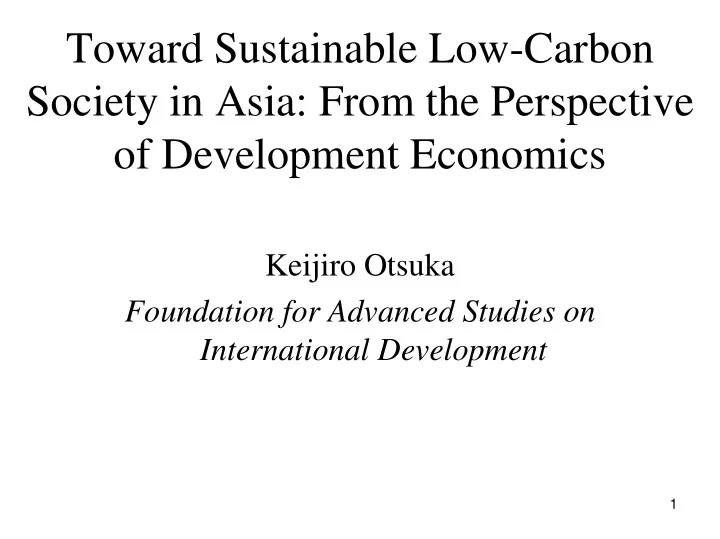

Toward Sustainable Low-Carbon Society in Asia: From the Perspective of Development Economics Keijiro Otsuka Foundation for Advanced Studies on International Development 1
Two Fundamental Issues 1. Free Riding -- Each country wants to let others build “low- carbon society” and enjoy the benefits arising from the reduced emission of greenhouse gases. -- How to induce cooperative behaviors? 2. Technology Solutions -- In order to avoid catastrophic results, we need technology solutions. -- How to create conditions conducive to the use of “carbon-saving” (or fossil energy-saving) cars, appliances, housing, and machines, and the development of “carbon-saving” technologies? 2
Assumptions that lead to free riding • For simplicity, assume that there are two countries of equal size, Japan and Country OAC. • If these two countries do no make any conscious efforts to reduce carbon emission, temperature will rise by 4 ℃ . This is the worst-case scenario. • If the two countries both reduce carbon emission by 50%, temperature will rise by 2 ℃ . This is the best- case scenario. • If only Japan reduces emission by 50%, temperature will rise by 3 ℃ . OAC is better-off than the best- scenario case, as it does not make any effort . 3
Prisoners’ Dilemma in Efforts to Reduce Greenhouse Gas Emission by Japan and OAC Japan No reduction 50% reduction No reduction -10 -12 OAC -10 -4 50% reduction -4 -5 -12 -5 4
Solution I: Commitment of 50% reduction by Japan and payment or technology transfer from Japan to OAC, if it also commits to 50% reduction Japan No reduction 50% reduction No reduction -12 OAC -4 50% reduction -5 -4 -5+4 5
Solution II: Larger Commitment of Japan and Smaller Requested Commitment of OAC Japan No reduction 70% reduction No reduction -15 OAC -2 30% reduction -9 -3? 6
Technology Solution • Technology is not exogenously given but developed based on the consideration of profitability. • What does “necessity is the mother of invention” mean? • It means that “rising price of a good (e.g., oil) induces the development of technology capable of reducing its use.” 7
8
Relationship between CO 2 emission (left-hand axis) and oil price (right-hand axis) in Japan, 1965-99 100 million tons (carbon equivalent) CIF oil price (real, yen/kl) 400 40,000 300 30,000 CO2 emission (left axis) 200 20,000 Real oil price (yen/kl) 100 10,000 0 0 65 75 85 95 Year Sources: Institute of Energy Economics Japan ed. (2001), EDMC Handbook of Energy and Economic Statistics in Japan 2001, Tokyo: Energy Conservation Center. 9
Don’t Expect EKC to hold! • U-shaped environmental Kuznets curve holds in the case of local environmental deterioration, e.g., emission of SO 2 and river contamination. • The literature in the environmental economics has established that the relationship between income and CO 2 emission is positive, because there is no perceived local costs arising from CO 2 emission. 10
Conclusions • If we REALLY want to build “low-carbon society in Asia,” (1) we should use Japan’s ODA judiciously so as to achieve consensus among Asian countries to reduce greenhouse gas emission substantially in the short run; (2) this leads to the forced reduction in the use of fossil energy and, hence, sharp increases in fossil energy prices, which will stimulate the adoption of carbon- saving or fossil energy-saving devices and the development and diffusion of fossil energy-saving technologies. 11
Recommend
More recommend